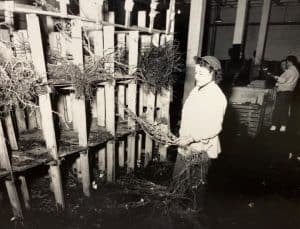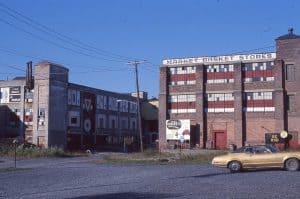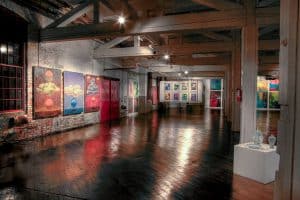Cracker Factory
By John Marks, Curator
The past two months I’ve written about the building at 35 Lehigh Street. It was built for the Geneva Shears Company, then used by its successors Geneva Cutlery and Geneva Forge. This is the final chapter of the story.
In the late 1950s Stern’s Nursery used the building as a packing house. The wood floors on the upper stories were covered in an inch and a half of tar, possibly for insulation. The building was kept cold so plants would stay dormant as they were sorted and packed. Photos show workers dressed in layers and with hats. Based on city directories, Stern’s was there from about 1958 to 1975.
In 1979, Elston Electronics moved from Phelps to Lehigh Street. The company, which produced computer monitors, grew to 492 employees in Geneva. In addition to factory space, drop ceilings and partitions created offices on the second floor.
Elston Electronics closed in May 1991 and the building was auctioned in August. The AXS Company moved in, buying and selling pre-owned office furniture. They made few changes to the interior of the building. All three floors were filled with chairs, desks, shelving, and cabinets.
Stern’s, Elston, and AXS only used the southern half of the building. Around 1947, Market Basket had taken over the northern half of the old cutlery factory. That part of the building is seen on the far left of the photo below.
After Market Basket closed in 1956, the complex was used by other businesses until 1986. With no improvements by the owners, the buildings were finally torn down in 2002. It was delicate work, as the “Market Basket half” of 35 Lehigh Street had to be removed from the rest of the building.
In 2004, Brandon and Amy Phillips moved their furniture company from Brooklyn to Yates County. They had access to trees on their land and made furniture in their barn. After a 2007 fire, they needed to quickly find a place to resume production. The old cutlery factory was in their price range, and was on par with modern, windowless metal buildings. While the building needed a lot of work, they were able to move into the first floor and begin working again.
What do you do with 65,000 square feet? Anything you want to! The second and third floors still had a lot of AXS furniture, and carpeting, drop ceilings, and offices from the Elston era. Amy and Brandon converted one section of the second floor into an apartment. The rest of that floor was opened up and the carpet and tar were carefully stripped off the wood.
They re-named the building the Cracker Factory, after a joke on The Simpsons television show. The non-profit group Three Stories was created to host and promote arts, literature, and music programming on the second floor.
The second floor is rented for special events. Industrial weddings at old warehouses and factories have become popular. The Cracker Factory has a steady stream of weddings, sometimes two in a weekend, in all seasons. Brandon and Amy bought the empty lot adjacent to their building, which is a popular spot for outdoor weddings and photographs.
The third floor is still undeveloped. As time, money, and inspiration allow, something may go in there. Stay tuned!





John, This is a great story about the use of an old warehouse. Thanks for doing the research and presenting the articles. Happy Holidays!
Thank you John,
Great story of how this building became the now famous Cracker Factory.
Merry Christmas!
Thanks, John. My father worked for F.M. Howell Company in Elmira. He designed and sold boxes. One of his clients was Geneva Cutlery. I used to have a set of knives. I especially enjoyed reading your blog because while I knew that he sold boxes to Geneva Cutlery, I didn’t know that the building that housed them is The Cracker Factory.